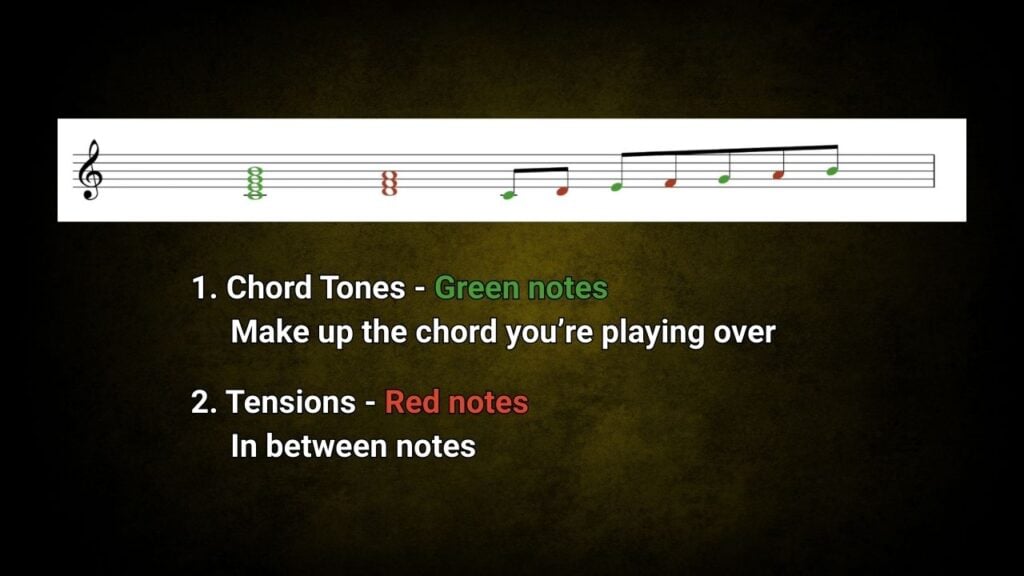
Practice This to Play Better Sax Solos
- By Jay Metcalf
- Improvisation Lessons, Saxophone-Lessons

Check out the audio podcast version of this post on Apple Podcasts or Spotify.
Are you tired of your solos falling flat even when you’re using the “right” notes?
I used to feel the same way, until I discovered a super simple practice method that eliminated wrong notes and finally made my soloing click.
This approach turns small scale patterns into full solos that land confidently on chord changes and sound impressive. Here’s how it works.
Not All Scale Notes Are Equal
Let’s start with why some notes sound off, even when they belong to the correct scale.
Every scale has two types of notes:
- Chord tones (what I like to call green notes)
- Tensions (the more adventurous red notes)

Imagine you’re Little Red Riding Hood walking to grandma’s house. The path is safe and reliable, just like the green notes. But there are interesting things off the path too: a tree to climb, some flowers to pick, and maybe even a cute little wolf. These are the red notes. They’re fun and colorful, but only if you know how to come back safely.
Knowing which notes are stable and which are colorful is important. But the real challenge is learning to resolve tension in real time. That’s what makes your solos sound intentional.
Easy Melodic Cell: 2-1-2-1
Let’s begin with a simple two-note melodic cell using scale degrees 2 and 1. It’s an easy tension-to-resolution movement.

Once you add some rhythm and apply it to a 12-bar blues progression, it already starts sounding musical. You’re not just playing random notes, you’re training your ears and fingers to resolve.
Easy Melodic Cell: 4-3-4-3
Now let’s add a new pair, scale degrees 4 and 3.

This gives us another great tension-resolution phrase, and it comes straight out of Adam Larson’s Magic of Melody course, which is included in the BetterSax Membership. Along with his other courses, Chord Tone Zone and Rhythmic Pyramid, these lessons give beginner and intermediate improvisers practical tools to play better solos.
The more you internalize how to resolve these red notes back to green ones, the more confident and musical your solos will sound.
Basic Melodic Cell Improvising
You probably see where this is going, scale degrees 6 to 5 is another easy tension-resolution cell.

Try practicing that one over the 12-bar blues progression. It’s simple but powerful.
From there, start playing improvised solos using these cells. Vary the rhythm. Explore different entries and exits. You’ll quickly find that your playing sounds more melodic and connected to the changes.
This is just scratching the surface. Inside Magic of Melody, there are many more ways to practice this approach that will lead you:
- Better Rhythm
- Stronger Melodic Ideas
- Able to Play Inside the Chord Changes
- Resolving tensions like a pro
Crafting Strong Melodies
I once heard some great advice from Miles Davis:

“Make your standards sound like originals and your originals sound like standards.”
He was talking about composition, but it applies to improvisation too.
If you want to solo well, focus on sounding melodic. When you study strong melodies, you’ll find they almost always use tension-resolution effectively. That’s what gives them strength and memorability.
Once you’ve practiced these melodic cells, you can build them into longer, faster ideas. A perfect tool for this is the pentatonic scale. It’s made of three green notes and two red ones, ideal for balancing stability and color.
Click here to read this article next, where I show you how to practice pentatonic patterns in a way that boosts your rhythm, technique, and soloing skills.
And if you’re serious about improving your saxophone sound, rhythm, and improvisation, Click Here to learn more about joining the BetterSax Membership. We’ve helped thousands of saxophone players take their improvisation to the next level, you can be one of them.
More Posts
Jay Metcalf
Leave a Comment
Your email address will not be published. Required fields are marked *
COURSES FOR
EVERY LEVEL
filter by difficulty using the tabs
- All
- Advanced
- Beginner
- Bundle
- Free
- Intermediate
- All
- Advanced
- Beginner
- Bundle
- Free
- Intermediate






Add your first comment to this post